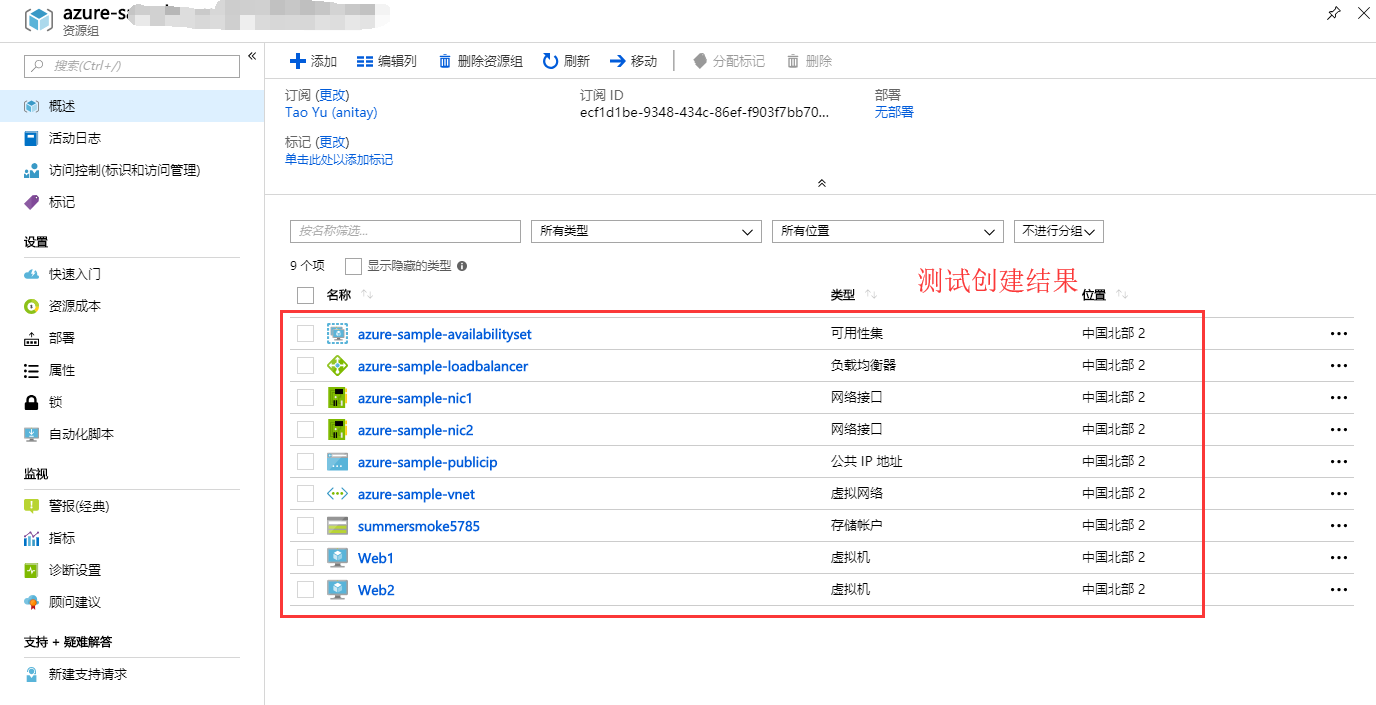概述
下面将演示如何使用Python SDK管理中国区Azure Load balancer。关于Azure负载均衡器的详细功能介绍,请参考官方文档。
Code Sample
import os
from azure.common.credentials import ServicePrincipalCredentials
from azure.mgmt.resource import ResourceManagementClient
from azure.mgmt.storage import StorageManagementClient
from azure.mgmt.network import NetworkManagementClient
from azure.mgmt.compute import ComputeManagementClient
from haikunator import Haikunator
haikunator = Haikunator()
# Azure Datacenter
LOCATION = 'China North2'
# Resource Group
GROUP_NAME = 'azure-sample-group-loadbalancer'
# Network
VNET_NAME = 'azure-sample-vnet'
SUBNET_NAME = 'azure-sample-subnet'
DOMAIN_LABEL_NAME = 'testdns'+haikunator.haikunate()
PUBLIC_IP_NAME = 'azure-sample-publicip'
# Load balancer
LB_NAME = 'azure-sample-loadbalancer'
FIP_NAME = 'azure-sample-frontendipname'
ADDRESS_POOL_NAME = 'azure-sample-addr-pool'
PROBE_NAME = 'azure-sample-probe'
LB_RULE_NAME = 'azure-sample-lb-rule'
NETRULE_NAME_1 = 'azure-sample-netrule1'
NETRULE_NAME_2 = 'azure-sample-netrule2'
FRONTEND_PORT_1 = 21
FRONTEND_PORT_2 = 23
BACKEND_PORT = 22
# VM
AVAILABILITY_SET_NAME = 'azure-sample-availabilityset'
OS_DISK_NAME = 'azure-sample-osdisk'
STORAGE_ACCOUNT_NAME = haikunator.haikunate(delimiter='')
IP_CONFIG_NAME = 'azure-sample-ip-config'
VMS_INFO = {
1: {
'name': 'Web1',
'nic_name': 'azure-sample-nic1',
'username': 'notadmin1',
'password': 'Pa$$w0rd91'
},
2: {
'name': 'Web2',
'nic_name': 'azure-sample-nic2',
'username': 'notadmin2',
'password': 'Pa$$w0rd92'
}
}
# Ubuntu config
PUBLISHER = 'Canonical'
OFFER = 'UbuntuServer'
SKU = '16.04-LTS'
VERSION = 'latest'
# Manage resources and resource groups - create, update and delete a resource group,
# deploy a solution into a resource group, export an ARM template. Create, read, update
# and delete a resource
#
# This script expects that the following environment vars are set:
#
# AZURE_TENANT_ID: with your Azure Active Directory tenant id or domain
# AZURE_CLIENT_ID: with your Azure Active Directory Application Client ID
# AZURE_CLIENT_SECRET: with your Azure Active Directory Application Secret
# AZURE_SUBSCRIPTION_ID: with your Azure Subscription Id
def run_example():
"""Resource Group management example."""
#
# Create all clients with an Application (service principal) token provider
#
subscription_id = "ecf1d1be-9348-434c-86ef-f903f7bb7111"
# your Azure Subscription Id
client_id = '42c02c81-eff8-4df6-8884-4e43b6ea8111'
client_secret = '111111'
tenant_id = 'b388b808-0ec9-4a09-a414-a7cbbd8b7111'
credentials = ServicePrincipalCredentials(client_id, client_secret, tenant=tenant_id, china='true')
resource_client = ResourceManagementClient(credentials, subscription_id, base_url='https://management.chinacloudapi.cn')
compute_client = ComputeManagementClient(credentials, subscription_id, base_url='https://management.chinacloudapi.cn')
storage_client = StorageManagementClient(credentials, subscription_id, base_url='https://management.chinacloudapi.cn')
network_client = NetworkManagementClient(credentials, subscription_id, base_url='https://management.chinacloudapi.cn')
# Create Resource group
print('Create Resource Group')
resource_client.resource_groups.create_or_update(GROUP_NAME, {'location': LOCATION})
# Create PublicIP
print('Create Public IP')
public_ip_parameters = {
'location': LOCATION,
'public_ip_allocation_method': 'static',
'dns_settings': {
'domain_name_label': DOMAIN_LABEL_NAME
},
'idle_timeout_in_minutes': 4
}
async_publicip_creation = network_client.public_ip_addresses.create_or_update(
GROUP_NAME,
PUBLIC_IP_NAME,
public_ip_parameters
)
public_ip_info = async_publicip_creation.result()
# Building a FrontEndIpPool
print('Create FrontEndIpPool configuration')
frontend_ip_configurations = [{
'name': FIP_NAME,
'private_ip_allocation_method': 'Dynamic',
'public_ip_address': {
'id': public_ip_info.id
}
}]
# Building a BackEnd address pool
print('Create BackEndAddressPool configuration')
backend_address_pools = [{
'name': ADDRESS_POOL_NAME
}]
# Building a HealthProbe
print('Create HealthProbe configuration')
probes = [{
'name': PROBE_NAME,
'protocol': 'Http',
'port': 80,
'interval_in_seconds': 15,
'number_of_probes': 4,
'request_path': 'healthprobe.aspx'
}]
# Building a LoadBalancer rule
print('Create LoadBalancerRule configuration')
load_balancing_rules = [{
'name': LB_RULE_NAME,
'protocol': 'tcp',
'frontend_port': 80,
'backend_port': 80,
'idle_timeout_in_minutes': 4,
'enable_floating_ip': False,
'load_distribution': 'Default',
'frontend_ip_configuration': {
'id': construct_fip_id(subscription_id)
},
'backend_address_pool': {
'id': construct_bap_id(subscription_id)
},
'probe': {
'id': construct_probe_id(subscription_id)
}
}]
# Building InboundNATRule1
print('Create InboundNATRule1 configuration')
inbound_nat_rules = [{
'name': NETRULE_NAME_1,
'protocol': 'tcp',
'frontend_port': FRONTEND_PORT_1,
'backend_port': BACKEND_PORT,
'enable_floating_ip': False,
'idle_timeout_in_minutes': 4,
'frontend_ip_configuration': {
'id': construct_fip_id(subscription_id)
}
}]
# Building InboundNATRule2
print('Create InboundNATRule2 configuration')
inbound_nat_rules.append({
'name': NETRULE_NAME_2,
'protocol': 'tcp',
'frontend_port': FRONTEND_PORT_2,
'backend_port': BACKEND_PORT,
'enable_floating_ip': False,
'idle_timeout_in_minutes': 4,
'frontend_ip_configuration': {
'id': construct_fip_id(subscription_id)
}
})
# Creating Load Balancer
print('Creating Load Balancer')
lb_async_creation = network_client.load_balancers.create_or_update(
GROUP_NAME,
LB_NAME,
{
'location': LOCATION,
'frontend_ip_configurations': frontend_ip_configurations,
'backend_address_pools': backend_address_pools,
'probes': probes,
'load_balancing_rules': load_balancing_rules,
'inbound_nat_rules' :inbound_nat_rules
}
)
lb_info = lb_async_creation.result()
##############################################################
# From here, we create the VM and link the LB inside the NIC #
##############################################################
# Create VNet
print('Create Vnet')
async_vnet_creation = network_client.virtual_networks.create_or_update(
GROUP_NAME,
VNET_NAME,
{
'location': LOCATION,
'address_space': {
'address_prefixes': ['10.0.0.0/16']
}
}
)
async_vnet_creation.wait()
# Create Subnet
async_subnet_creation = network_client.subnets.create_or_update(
GROUP_NAME,
VNET_NAME,
SUBNET_NAME,
{'address_prefix': '10.0.0.0/24'}
)
subnet_info = async_subnet_creation.result()
# Creating NIC
print('Creating NetworkInterface 1')
back_end_address_pool_id = lb_info.backend_address_pools[0].id
inbound_nat_rule_1_id = lb_info.inbound_nat_rules[0].id
async_nic1_creation = network_client.network_interfaces.create_or_update(
GROUP_NAME,
VMS_INFO[1]['nic_name'],
create_nic_parameters(subnet_info.id, back_end_address_pool_id, inbound_nat_rule_1_id)
)
inbound_nat_rule_2_id = lb_info.inbound_nat_rules[1].id
print('Creating NetworkInterface 2')
async_nic2_creation = network_client.network_interfaces.create_or_update(
GROUP_NAME,
VMS_INFO[2]['nic_name'],
create_nic_parameters(subnet_info.id, back_end_address_pool_id, inbound_nat_rule_2_id)
)
nic1_info = async_nic1_creation.result()
nic2_info = async_nic2_creation.result()
# Create availability set
print('Create availability set')
availability_set_info = compute_client.availability_sets.create_or_update(
GROUP_NAME,
AVAILABILITY_SET_NAME,
{'location': LOCATION}
)
# Create a storage account
print('Create a storage account')
storage_async_operation = storage_client.storage_accounts.create(
GROUP_NAME,
STORAGE_ACCOUNT_NAME,
{
'sku': {'name': 'standard_lrs'},
'kind': 'storage',
'location': LOCATION
}
)
storage_async_operation.wait()
# Create VMs
print('Creating Virtual Machine 1')
vm_parameters1 = create_vm_parameters(nic1_info.id, availability_set_info.id, VMS_INFO[1])
async_vm1_creation = compute_client.virtual_machines.create_or_update(
GROUP_NAME, VMS_INFO[1]['name'], vm_parameters1)
async_vm1_creation.wait()
print('Creating Virtual Machine 2')
vm_parameters2 = create_vm_parameters(nic2_info.id, availability_set_info.id, VMS_INFO[2])
async_vm2_creation = compute_client.virtual_machines.create_or_update(
GROUP_NAME, VMS_INFO[2]['name'], vm_parameters2)
async_vm2_creation.wait()
provide_vm_login_info_to_user(1, public_ip_info, FRONTEND_PORT_1, VMS_INFO[1])
provide_vm_login_info_to_user(2, public_ip_info, FRONTEND_PORT_2, VMS_INFO[2])
input("Press enter to delete this Resource Group.")
# Delete Resource group and everything in it
print('Delete Resource Group')
delete_async_operation = resource_client.resource_groups.delete(GROUP_NAME)
delete_async_operation.wait()
print("
Deleted: {}".format(GROUP_NAME))
def construct_fip_id(subscription_id):
"""Build the future FrontEndId based on components name.
"""
return ('/subscriptions/{}'
'/resourceGroups/{}'
'/providers/Microsoft.Network'
'/loadBalancers/{}'
'/frontendIPConfigurations/{}').format(
subscription_id, GROUP_NAME, LB_NAME, FIP_NAME
)
def construct_bap_id(subscription_id):
"""Build the future BackEndId based on components name.
"""
return ('/subscriptions/{}'
'/resourceGroups/{}'
'/providers/Microsoft.Network'
'/loadBalancers/{}'
'/backendAddressPools/{}').format(
subscription_id, GROUP_NAME, LB_NAME, ADDRESS_POOL_NAME
)
def construct_probe_id(subscription_id):
"""Build the future ProbeId based on components name.
"""
return ('/subscriptions/{}'
'/resourceGroups/{}'
'/providers/Microsoft.Network'
'/loadBalancers/{}'
'/probes/{}').format(
subscription_id, GROUP_NAME, LB_NAME, PROBE_NAME
)
def provide_vm_login_info_to_user(num, public_ip_info, frontend_port, vm_info):
"""Print on the console the connection information for a given VM.
"""
print('
Login information for the {} VM: {}'.format(num, vm_info['name']))
print('-------------------------------------------')
print('ssh to ip:port - {}:{}'.format(public_ip_info.ip_address, frontend_port))
print('username - {}'.format(vm_info['username']))
print('password - {}'.format(vm_info['password']))
def create_nic_parameters(subnet_id, address_pool_id, natrule_id):
"""Create the NIC parameters structure.
"""
return {
'location': LOCATION,
'ip_configurations': [{
'name': IP_CONFIG_NAME,
'subnet': {
'id': subnet_id
},
'load_balancer_backend_address_pools': [{
'id': address_pool_id
}],
'load_balancer_inbound_nat_rules': [{
'id': natrule_id
}]
}]
}
def create_vm_parameters(nic_id, availset_id, vm_info):
"""Create the VM parameters structure.
"""
return {
'location': LOCATION,
'os_profile': {
'computer_name': vm_info['name'],
'admin_username': vm_info['username'],
'admin_password': vm_info['password']
},
'hardware_profile': {
'vm_size': 'Standard_A1'
},
'storage_profile': {
'image_reference': {
'publisher': PUBLISHER,
'offer': OFFER,
'sku': SKU,
'version': VERSION
},
'os_disk': {
'name': OS_DISK_NAME,
'caching': 'None',
'create_option': 'fromImage',
'vhd': {
'uri': 'https://{}.blob.core.chinacloudapi.cn/vhds/{}.vhd'.format(
STORAGE_ACCOUNT_NAME, vm_info['name'])
}
},
},
'network_profile': {
'network_interfaces': [{
'id': nic_id,
'primary': True
}]
},
'availability_set': {
'id': availset_id
}
}
if __name__ == "__main__":
run_example()
关于认证信息的获取,可以参考链接方式二: 通过 PowerShell 获取认证凭据部分。
注意: 示例代码修改了部分参数,如sku,因为区域的问题,某些vm size可能会出现不支持的情况;镜像及api-version也可能出现不支持的情况,具体需要结合报错信息调整代码。
测试结果

参考链接
Getting Started with Azure Resource Manager for load balancers in Python